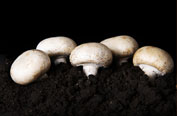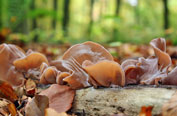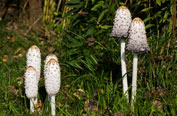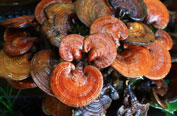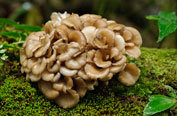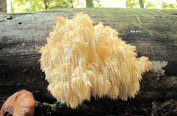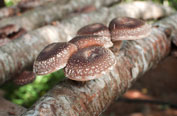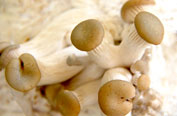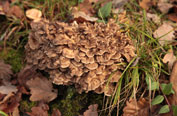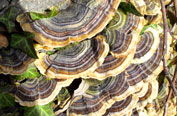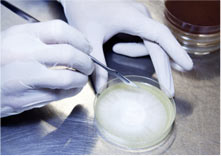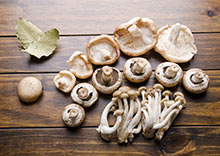
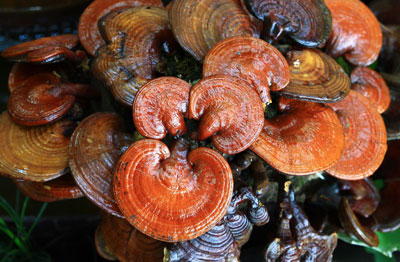
Allgemeines
-
Ganoderma lucidum
Synonyme: Reishi, Ling Zhi / Ling Chi, Glänzender Lackporling, Mannentake, Zehntausend-Jahre-PilzInhaltsstoffe: u.a. Polysaccharide, Triterpene, Ganoderane, B-, D-, und E-Vitamine, Eisen, Magnesium, Kupfer, Zink, Germanium
Traditionelle Anwendungsgebiete:
- Begleitend zur Krebstherapie (1-15)
- Allergien (16-20)
- leberstärkend (21-29)
- Bluthochdruck (30,31)
- Schlaflosigkeit (32-34)
- Gelenksrheumatismus (35)
- Anti-Aging (36-40)
- Stimulierung der Immunabwehr (41-45)
- Prävention von Herz-Kreislauf-Erkrankungen (46, 47)
Seine immunmodulierenden und entzündungshemmenden Effekte machen den Ganoderma lucidum zu einem idealen Mittel gegen Allergien (sh. Ganoderma lucidum (16 - 20)).
Der Ganoderma lucidum entfaltet eine breite Wirkung auf die Gesundheit von Herz und Gefässen. Aus Ganoderma lucidum isolierte Polysaccharide und Triterpene zeigten eine blutfettsenkende, antithrombotische und blutdrucksenkende Wirkung und minderten Herzklopfen und Kurzatmigkeit. (sh. Ganoderma lucidum (30, 31))
Der traditionelle Name „Pilz des Geistes“ deutet schon auf die beruhigende Wirkung der in Ganoderma lucidum enthaltenen Triterpene auf das ZNS hin, viele Heilkundler schätzen ihn in Fällen von Schlaflosigkeit (sh. Ganoderma lucidum (32 - 34)).
In Fällen von rheumatoider Arthritis kann die dem Ganoderma lucidum eigene Kombination aus immunmodulierender und entzündungshemmender Wirkung ihr großes Potential entfalten. Einer Proteoglukan-Fraktion aus Ganoderma lucidum konnte in-vitro eine hemmende Wirkung auf die pathologische Veränderung der Gelenksfibroblasten nachgewiesen werden (sh. Ganoderma lucidum (35)).
Über den Pilz:
Verbreitung und Habitat in der Natur:
Ganoderma lucidum ist ein holzbewohnender Saprophyt, der vor allem Laubhölzer wie Eichen, Buchen, Erlen oder Birken besiedelt. Er bevorzugt warme Eichen- bzw. Eichenmischwälder, daneben Rotbuchenwälder oder Hartholzauen. Aber auch an Hecken, in Parks und an Wegrändern kann er gefunden werden, wenn dort die entsprechenden Voraussetzungen gegeben sind. Er ist vor allem in mediterranen und gemäßigten Gegenden verbreitet, in Europa kommt er bis ins südliche Skandinavien vor. In Deutschland und Österreich ist der Glänzende Lackporling im gesamten Gebiet unterschiedlich dicht verbreitet.
Verwendung:
Vitalpilz
Dieser Pilz wird in China Ling Zhi und in Japan Reishi genannt. Überlieferungen gehen von einer etwa 4.000-jährigen Geschichte dieses faszinierenden Pilzes aus! Der Reishi ist in Ostasien traditionell ein Symbol für Gesundheit, körperliche und geistige Genesung, langes Leben, hohe sexuelle Aktivität, Weisheit und Reichtum. Der Reishi ist reich an Mikronährstoffen wie Eisen, Magnesium, Kalzium, Zink, Kupfer, Mangan und Germanium. Besonders wertvoll sind die im Reishi enthaltenen Polysaccharide und Triterpene wie Ganodermiksäuren, Ganolucidsäuren und Lucidemiksäuren. Studien
-
Wissenschaftliche Studien über Ganoderma lucidum
1) Anticancer effects of Ganoderma lucidum: a review of scientific evidence. Yuen J.W, Gohel M.D. Nutr Cancer. 2005;53(1):11-7.2) Regression of gastric large B-Cell lymphoma accompanied by a florid lymphoma-like T-cell reaction: immunomodulatory effect of Ganoderma lucidum (Lingzhi)? Cheuk W, Chan J.K, Nuovo G, Chan M.K, Fok M. Int J Surg Pathol. 2007;15(2):180-6.
3) Potential of a novel polysaccharide preparation (GLPP) from Anhui-grown Ganoderma lucidum in tumor treatment and immunostimulation. Pang X, Chen Z, Gao X, Liu W, Slavin M, Yao W, Yu L.L. J Food Sci. 2007;72(6):S435-42.
4) Cytotoxic triterpenoids from Ganoderma lucidum. Cheng C.R, Yue Q.X, Wu Z.Y, Song X.Y, Tao S.J, Wu X.H, Xu P.P, Liu X, Guan S.H, Guo D.A. Phytochemistry. 2010;71(13):1579-1585.
5) Triterpenes from Ganoderma lucidum induce autophagy in colon cancer through the inhibition of p38 mitogen-activated kinase (p38 MAPK). Thyagarajan A, Jedinak A, Nguyen H, Terry C, Baldridge L.A, Jiang J, Sliva D. Nutr Cancer. 2010;62(5):630-40.
6) Ganoderic acid T inhibits tumor invasion in vitro and in vivo through inhibition of MMP expression. Chen N.H, Liu J.W, Zhong J.J. Pharmacol Rep. 2010;62(1):150-63.
7) Inhibitory effects of ganoderma lucidum on tumorigenesis and metastasis of human hepatoma cells in cells and animal models. Weng C.J, Chau C.F, Yen G.C, Liao J.W, Chen D.H, Chen K.D. J Agric Food Chem. 2009;57(11):5049-57.
8) Cytotoxic lanostanoid triterpenes from Ganoderma lucidum. Guan S.H, Xia J.M, Yang M, Wang X.M, Liu X, Guo D.A. J Asian Nat Prod Res. 2008;10(7-8):705-10.
9) The anti-invasive effect of lucidenic acids isolated from a new Ganoderma lucidum strain. Weng C.J, Chau C.F, Chen K.D, Chen D.H, Yen G.C. Mol Nutr Food Res. 2007;51(12):1472-7.
10) Lucidenic acids P and Q, methyl lucidenate P, and other triterpenoids from the fungus Ganoderma lucidum and their inhibitory effects on Epstein-Barr virus activation. Iwatsuki K, Akihisa T, Tokuda H, Ukiya M, Oshikubo M, Kimura Y, Asano T, Nomura A, Nishino H.J Nat Prod. 2003 Dec;66(12):1582-5.
11) Suppression of the inflammatory response by triterpenes isolated from the mushroom Ganoderma lucidum. Dudhgaonkar S, Thyagarajan A, Sliva D.Int Immunopharmacol. 2009;9(11):1272-80.
12) Ganoderma lucidum suppresses motility of highly invasive breast and prostate cancer cells. Sliva D, Labarrere C, Slivova V, Sedlak M, Lloyd F.P Jr, Ho N.W. Biochem Biophys Res Commun. 2002;298(4):603-12.
13) Ganoderma lucidum suppresses growth of breast cancer cells through the inhibition of Akt/NF-kappaB signaling. Jiang J, Slivova V, Harvey K, Valachovicova T, Sliva D. Nutr Cancer. 2004;49(2):209-16.
14) Effects of ganopoly (a Ganoderma lucidum polysaccharide extract) on the immune functions in advanced-stage cancer patients. Gao Y, Zhou S, Jiang W, Huang M, Dai X. Immunol Invest. 2003;32(3):201-15.
15) Effects of water-soluble Ganoderma lucidum polysaccharides on the immune functions of patients with advanced lung cancer. Gao Y, Tang W, Dai X, Gao H, Chen G, Ye J, Chan E, Koh H.L, Li X, Zhou S. J Med Food. 2005;8(2):159-68.
16) Anti-allergic constituents in the culture medium of Ganoderma lucidum. (I). Inhibitory effect of oleic acid on histamine release. Tasaka K, Akagi M, Miyoshi K, Mio M, Makino T. Inflammation Research. 1988;23(3-4):153-6
17) Anti-allergic constituents in the culture medium of Ganoderma lucidum. (II). The inhibitory effect of cyclooctasulfur on histamine release. Tasaka K, Mio M, Izushi K, Akagi M, Makino T. Inflammation Research. 1988;23(3-4):157-60.
18) Effectiveness of Dp2 nasal therapy for Dp2- induced airway inflammation in mice: using oral Ganoderma lucidum as an immunomodulator. Liu Y.H, Tsai C.F, Kao M.C, Lai Y.L, Tsai J.J. J Microbiol Immunol Infect. 2003;36(4):236-428.
19) The use of Ganoderma lucidum (Reishi) in the management of Histamine-mediated allergic responses. Powell M. Nutritional Practitioner Magazine. October 2004
20) The Chinese herbal medicine formula FAHF-2 completely blocks anaphylactic reactions in murine model of peanut allergy. Srivastava K.D, Kattan J.D, Zou Z.M, Li J.H, Zhang L, Wallenstein S, Goldfarb J, Sampson H.A, Li X.M. J Allergy Clin Immunol. 2005;115(1):171-8.
21) Antimutagenic activity of methanolic extract of Ganoderma lucidum and its effect on hepatic damage caused by benzo[a]pyrene. Lakshmi B, Ajith T.A, Jose N, Janardhanan K.K. J Ethnopharmacol. 2006;107(2):297-303.
22) Effects of Ganoderma lucidum polysaccharide on CYP2E1, CYP1A2 and CYP3A activities in BCG-immune hepatic injury in rats. Wang X, Zhao X, Li D, Lou Y.Q, Lin Z.B, Zhang G.L. Biol Pharm Bull. 2007;30(9):1702-6.
23) Post-treatment of Ganoderma lucidum reduced liver fibrosis induced by thioacetamide in mice. Wu Y.W, Fang H.L, Lin W.C. Phytother Res. 2010;24(4):494-9.
24) In vitro and in vivo protective effects of proteoglycan isolated from mycelia of Ganoderma lucidum on carbon tetrachloride-induced liver injury. Yang X.J, Liu J, Ye L.B, Yang F, Ye L, Gao J.R, Wu Z.H. World J Gastroenterol. 2006;12(9):1379-85.
25) Antifibrotic effects of a polysaccharide extracted from Ganoderma lucidum, glycyrrhizin, and pentoxifylline in rats with cirrhosis induced by biliary obstruction. Park E.J, Ko G, Kim J, Sohn D.H. Biol Pharm Bull. 1997;20(4):417-20.
26) Ganoderma lucidum extract attenuates the proliferation of hepatic stellate cells by blocking the PDGF receptor. Wang G.J, Huang Y.J, Chen D.H, Lin Y.L. Phytother Res. 2009;23(6):833-9.
27) Treatment of chronic hepatitis B with Wulingdan Pill. Journal of the fourth Military Medical College. 8:380-383. From Abstracts of Chinese Medicines 2:188
28) Effects of total Triterpenoids extract from Ganoderma lucidum (Curt.: Fr.) P. Karst. (Reishi Mushroom) on experimental liver injury models induced by Carbon Tetrachloride or D-Galactosamine in mice. Lin Z.B, Wang M.Y, Liu Q, Che Q.M. Int J Med Mushr. 2002;4(1):37-41
29) Anti-hepatitis B activities of ganoderic acid from Ganoderma lucidum. Li Y.Q, Wang S.F. Biotechnol Lett. 2006;28(11):837-41.
30) A phase I/II study of ling zhi mushroom Ganoderma lucidum (W.Curt.:Fr.) Lloyd (Aphyllophoromycetideae) extract in patients with coronary heart disease. Gao Y, Chen G, Dai X, Ye J, Zhou S. Int J Med Mushr. 2004;6(4):30
31) Effect of Ganoderma lucidum on the quality and functionality of Korean traditional rice wine, yakju. Kim J.H, Lee D.H, Lee S.H, Choi S.Y, Lee J.S. J Biosci Bioeng. 2004;97(1):24-8.
32) A preliminary study on the sleep-improvement function of the effective ingredients of Ganoderma lucidum fruitbody. Jia W, Wu M, Zhang J.S, Liu Y.F. Acta Edulis Fungi. 2005;12(3):43-47
33) Sleep-promoting effects of Ganoderma extracts in rats: comparison between long-term and acute administrations. Honda K, Komoda Y, Inoué S. Tokyo Ika Shika Daigaku Iyo Kizai Kenkyusho Hokoku. 1988;22:77-82.
34) Extract of Ganoderma lucidum potentiates pentobarbital-induced sleep via a GABAergic mechanis. Chu Q.P, Wang L.E, Cui X.Y, Fu H.Z, Lin Z.B, Lin S.Q, Zhang Y.H. Pharmacology Biochemistry and Behavior 2007;86(4):693-698
35) Ganoderma lucidum polysaccharide peptide reduced the production of proinflammatory cytokines in activated rheumatoid synovial fibroblast. Ho Y.W, Yeung J.S, Chiu P.K, Tang W.M, Lin Z.B, Man R.Y, Lau C.S. Mol Cell Biochem. 2007;301(1-2):173-9.
36) Antagonizing beta-amyloid peptide neurotoxicity of the anti-aging fungus Ganoderma lucidum. Lai C.S, Yu M.S, Yuen W.H, So K.F, Zee S.Y, Chang R.C. Brain Res. 2008;1190:215-24.
37) Novel hypoglycemic effects of Ganoderma lucidum water-extract in obese/diabetic (+db/+db) mice. Seto S.W, Lam T.Y, Tam H.L, Au A.L, Chan S.W, Wu J.H, Yu P.H, Leung G.P, Ngai S.M, Yeung J.H, Leung P.S, Lee S.M, Kwan Y.W. Phytomedicine. 2009;16(5):426-36.
38) Cholesterol-lowering properties of Ganoderma lucidum in vitro, ex vivo, and in hamsters and minipigs. Berger A, Rein D, Kratky E, Monnard I, Hajjaj H, Meirim I, Piguet-Welsch C, Hauser J, Mace K, Niederberger P. Lipids Health Dis. 2004;3:2.
39) Ganoderic acid and its derivatives as cholesterol synthesis inhibitors. Komoda Y, Shimizu M, Sonoda Y, Sato Y. Chem Pharm Bull (Tokyo). 1989;37(2):531-3.
40) Anti-atherosclerotic properties of higher mushrooms (a clinico-experimental investigation). Li K.R, Vasil’ev A.V, Orekhov A.N, Tertov V.V, Tutel’ian V.A. Vopr Pitan. 1989;(1):16-9.
41) Bao XF, Wang XS, Dong Q, Fang JN, Li XY : Structural features of immunologically active polysaccharides from Ganoderma lucidum Lexikon. Phytochemistry. 2002 Jan;59(2):175-81
42) Zhang J, Tang Q, Zimmerman-Kordmann M, Reutter W, Fan H: Activation of B lymphocytes by GLIS, a bioactive proteoglycan from Ganoderma lucidum Lexikon. Life Sci. 2002 Jun 28;71(6):623-38.
43) Ji Z, Tang Q, Zhang J, Yang Y, Jia W, Pan Y: Immunomodulation of RAW264.7 macrophages by GLIS, a proteopolysaccharide from Ganoderma lucidum Lexikon. J Ethnopharmacol. 2007;112(3):445-50.
44) Hua KF, Hsu HY, Chao LK, Chen ST, Yang WB, Hsu J, Wong CH: Ganoderma lucidum Lexikon polysaccharides enhance CD14 endocytosis of LPS and promote TLR4 signal transduction of cytokine expression. J Cell Physiol. 2007;212(2):537-50.
45) Kuo MC, Weng CY, Ha CL, Wu MJ :Ganoderma lucidum mycelia enhance innate immunity by activating NF-kappaB. J Ethnopharmacol. 2006 Jan 16;103(2):217-22.
46) Li Khva Ren , Vasil'ev AV, Orekhov AN, Tertov VV, Tutel'ian VA: Anti-atherosclerotic properties of higher mushrooms (a clinico-experimental investigation) Vopr Pitan. 1989 Jan-Feb;(1):16-9.
47) Wachtel-Galor S, Tomlinson B, Benzie IF: Ganoderma lucidum Lexikon ("Lingzhi"), a Chinese medicinal mushroom: biomarker responses in a controlled human supplementation study. Br J Nutr. 2004 Feb;91(2):263-9. Taxonomie
-
Taxonomie:
Klasse: Ständerpilze (Basisdiomycetes)
Unterklasse: Porenpilze (Polyporales)
Ordnung: Lackporlingsartige (Ganodermataceae)
Familie: Lackporlinge (Ganoderma)
Gattung: Glänzender Lackporling
Sporen: rötlich- braun, von ellipsoider Form mit abgestumpften Enden, zwischen 9 - 12 x 5,5 - 8 µ Zuchtbedingungen
-
Zuchtbedingungen
Phase 1: Myzelwachstum
Temperatur: 21 - 27°C
Luftfeuchte: 95 - 100%
Dauer: 10 - 20 Tage
CO2: toleriert bis zu 50,000 ppm oder 5%
Raumluftwechsel: 0 - 1 pro Stunde
Licht: -
Phase 2: Aufstellen der Myzelien / Einleitung der Fruchtung (Geweihform)
Temperatur: 18 - 24°C
Luftfeuchte: 95 - 100%
Dauer: 14 - 28 Tage
CO2: 20,000 - 40,000 ppm
Raumluftwechsel: 0 - 1 pro Stunde
Licht: 200 - 500 Lux für 4 - 8 Stunden pro Tag
Phase 2: Einleitung der Fruchtung (Hutform)
Temperatur: 21 - 27 °C
Luftfeuchte: 95 - 100%
Dauer: 14 - 28 Tage
CO2: 5,000 - 2,000 ppm
Raumluftwechsel: Je nach gewünschtem C02 Wert
Licht: 750 - 1,500 für 12 Stunden pro Tag
Phase 3: Fruchtung und Ernte
Temperatur: 21 - 27 °C
Luftfeuchte: 90 - 95%
Dauer: 60 Tage
CO2: <2,000 ppm
Raumluftwechsel: Je nach gewünschtem C02 Wert
Licht: 750 - 1,500 für 12 Stunden pro Tag
Erntewellen: 2 Ernten in 90 - 120 Tagen
Geeignetes Substrat:
Laubholz (besonders geeignet: Eiche, Erle, Buche, Birke)

